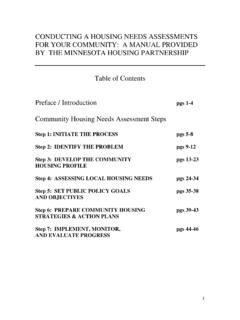Transcription of Real Estate Development Policies and Procedures Manual
1 real Estate Development Policies and Procedures Manual August 11, 2006 2 Acknowledgement Our thanks to LISC for providing the funding for this Manual , and to Project for Pride in Living, Inc. for assembly of the information and documents. A special thank you to PPL s summer intern, Andrew White, who tabulated the text and the appendix and provided technical support for the flow charts. 3 How to use this Manual : This Manual was designed by a Midwest Development organization, with your use in mind. While there will be some regional differences, and the material was not designed for all markets, we hope that you will find the examples and information useful. For the sake of simplicity, sections of the Manual were divided by color.
2 If you break out the colored pages you will have a guide to marketing, a guide to finance, a guide to project management, etc. If you are interested only in the examples and flow charts, you can print out the Appendix separately. 4 INDEX Policies 1. Mission/Strategic Project Selection Criteria Target Level of Development Activity Narrowing or Eliminating production Activity 2. Governance Board Members Articles of Incorporation and Bylaw Provisions Entering into Contracts Approving Deals 3. Working Capital, Cash Flow Management, and Feasibility Advances by the Consultant Predevelopment Advances from the Consultant Predevelopment Borrowing 4.
3 Interdepartmental Review and Plans and Specifications Operating Budgets Predevelopment and Development Budgets 5 INDEX (cont) ORGANIZING THE PROJECT - Procedures Project FLOW Chart Organizing and Managing the I. Feasibility 1. Market Market Study 2. Finance Estimate Project Costs 3. Physical Building Site 4. Stakeholder/Political Support for Project 5. Project Management Project Team 6. Board and Internal Feasibility Within Organization II. Project Assembly and Deal 1. Market Clients/Customers/Marketing Materials/Sales or Lease-up 2. Finance Applications 3. Physical Building Architect/General Contractor/Construction Bidding 4. Stakeholder/Political Regulatory 5.
4 Project Management Consultants/Partnerships 6. Board and Internal Recognition/Approvals III. 1. Market Marketing Office 2. Finance Draws 3. Physical Building Construction Schedule 4. Stakeholder/Political Events/Support 5. Project Management Consultants/Services 6. Board and Internal Response/Reports IV. Property Management or 1. Market Buyers/Renters 2. Finance Fees 3. Physical Building Completion 4. Stakeholder/Political Relationships 5. Project Management Turnover/Resolving Problems of Past Projects 6. Board and Internal Property Management 6 INDEX (cont) 1. Organization of Key Project 2. Terms and Appendixes 7 Policies 1. Mission/Strategic Plan Project Selection Criteria Target Level of Development Activity Narrowing or Eliminating production Activity The mission of the organization (the CDC) establishes the focus of the organization and identifies a need or series of needs in the community to which the organization will respond.
5 The Board of Directors, all of whom must believe in the mission, will be responsible for developing a Strategic Plan with the staff to set the course on how the mission will be accomplished over a specific period of time (3 year, 5 year etc). Out of this discourse and over time the Board will develop Policies to guide the organization. The Policies may answer: Who are we going to serve? Where or what geographic area? How are we going to do it by housing , business Development , and/or service programs? In the not-for-profit Development world, housing projects focus on helping people in need, by helping neighborhoods become sustainable by offering affordable and market rate units, and by creating wealth where it has not existed or been attainable through homeownership.
6 The mission of an organization which may include producing affordable housing as a long term objective-- provides the context for the organization s Development activities. Policy: Project Selection Criteria Develop a policy around your selection criteria. Projects are selected based on mission, capacity, and political will. An organization must have the capability to deliver a project that is economically feasible and financially viable within a community setting where there is support from its stakeholders. The most basic questions to be asked are: - does this project fit our mission and strategic plan? - do we have an experienced team to manage this project? - is there funding available for the Development of this project and is the project designed for long term economic viability?
7 - is there support from the stakeholders: the organization s Board of Directors, the neighborhood, the funding community, your clients, and representatives in city government? When these four major criteria come together they form a core that supports a project. That support is summarized in the graph featured on the next page. 8 9 Policy: Target Level of Development Activity do as much as you can do with your limited resources Develop Policies based on your capacity and your resources. Development activity depends on the availability of resources. The capacity of the organization will determine the size of projects that it will develop, and available sites will determine where Development will occur, but the limiting agent for all production is the availability of capital.
8 Market rate apartments or homeownership units are not affordable to low income people; the Development of these housing units requires subsidies and there is serious competition for the limited funding from government subsidized programs. Multiple financial products and partners will need to be assembled for larger projects to succeed. The key components for targeting activity are: availability of capital Subsidy for rental or homeownership Capacity of the organization Political and neighborhood will Site availability Market forces Develop Policies regarding where you will respond to needs. In addition to the capital you must raise and your organization s capacity, the other key considerations for Development will be a combination of determining where to locate a needed housing program and a neighborhood s or community s will to support or allow Development of the program nearby.
9 Assessing the market forces at work in a specific location will be necessary in making a final decision on where you will locate your project. In the end, the location and type of needed housing in your community and the neighborhood support will all be factors in determining your housing policy. Policy: Narrowing or Eliminating production Activity determine in what areas you are not going to be involved Develop Policies that will limit what you will produce. Just as important as determining your target selection criteria and the level of your Development activity, is having the Board decide the areas in which you will not get involved. The mission may fit, the resources may be there, the neighborhood would support it, but these production activities you will not do.
10 For example, you may decide not to do commercial Development , or not to become involved in senior housing Development , or not to provide property management services. You may prefer to do large multifamily projects so you determine you will not build projects with less than 20 units, or you may focus on rehabilitation of buildings and decide not to build new construction. These preferences may be based on competition, location, capacity, availability , market or other reasons. Whatever the reasons, they are part of your Development policy. 10 Policies (cont) 2. Governance Policies Board Members Articles of Incorporation and Bylaw Provisions Entering into Contracts Approving Deals The governance Policies of the organization (the CDC) may legally limit or set boundaries where the organization may work and may define their client/customer base.

